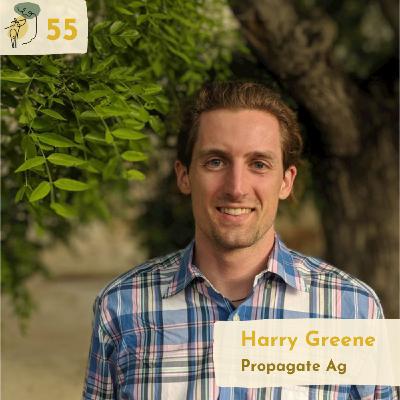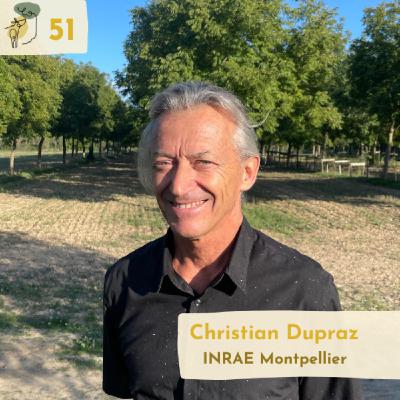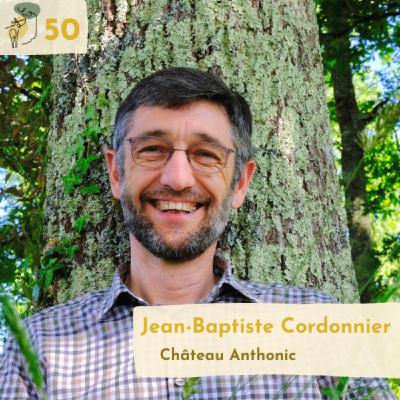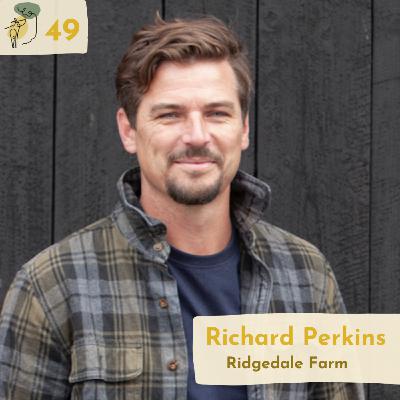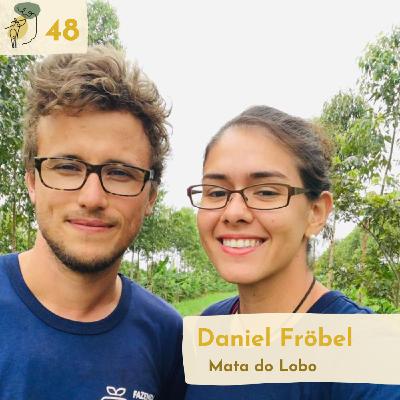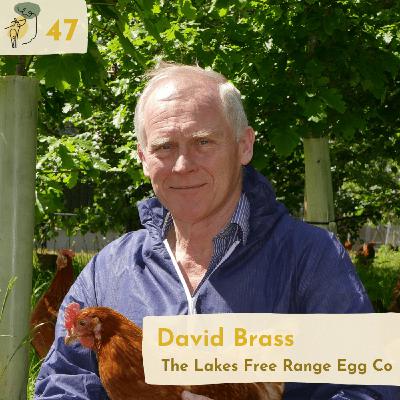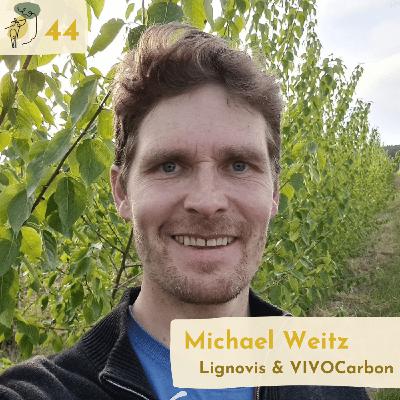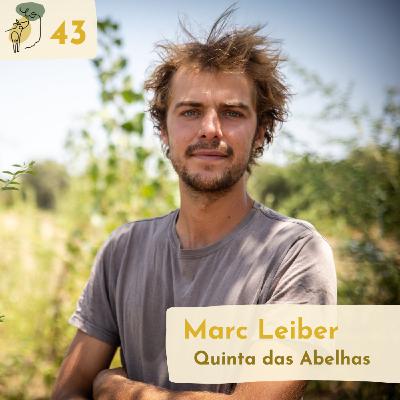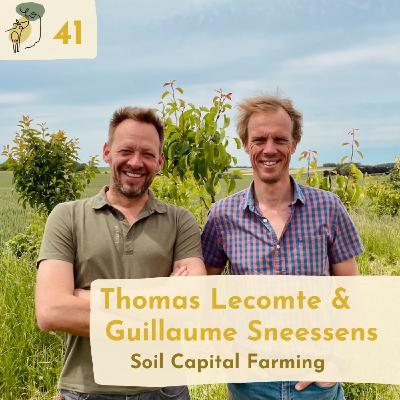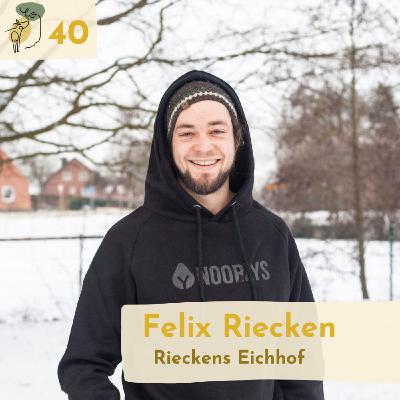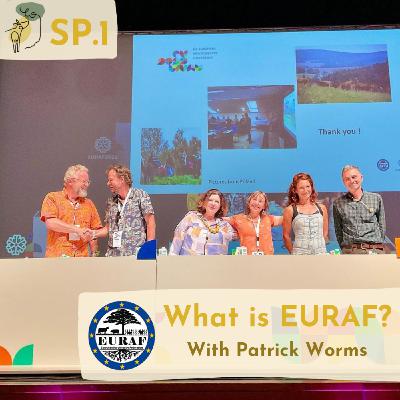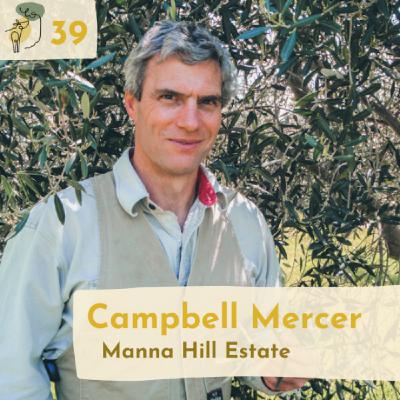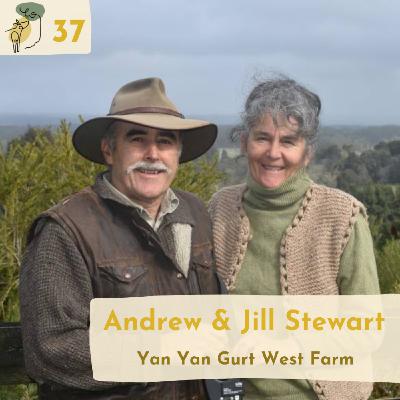Discover The Regenerative Agroforestry Podcast
The Regenerative Agroforestry Podcast

The Regenerative Agroforestry Podcast
Author: Dimitri Tsitos & Etienne Compagnon
Subscribed: 227Played: 4,082Subscribe
Share
© Dimitri Tsitos & Etienne Compagnon
Description
A space where we investigate the possibilities of agroforestry, share experiences and analyse different strategies, tools and techniques. We bring you quality, in-depth content, so that we can build together regenerative agroforestry systems.
Hosted on Acast. See acast.com/privacy for more information.
57 Episodes
Reverse
Propagate is a leader in the agroforestry space, specialising in project development and planting agroforestry systems at scale. It's a huge pleasure to chat with Harry, co-founder and Chief Research Officer of the US-based company. Tune in as we geek out on agroforestry economics, economic modelling, design implications and financing options. We delve into questions such as: How do you business plan agroforestry systems? How do we find a balance between economic performance and ecosystem services? And much more!• RESOURCEShttps://www.propagateag.com/• GET IN TOUCH www.regenerativeagroforestry.org• SUPPORT US www.gumroad.com/regenagroforestry• FOLLOW US on Twitter, Facebook, LinkedIn and Instagram• FUNDING FOR EUROPEAN PROJECTS https://explore.ecosia.org/regenerative-agriculture Hosted on Acast. See acast.com/privacy for more information.
In this episode I discuss with Claire Lemarié her experience working with farmers in the Pays de la Loire region in France, where she is a technical adviser for the chamber of agriculture. She has precious insights into the management of mature hedges, as this region still has a significant amount of bocage: a traditional french hedge layout. In this interview we gain an understanding of why effective information sharing between farmers is crucial to creating innovative agroforestry systems and how she enables peer to peer exchange through the 'Club des Agroforestiers'.• RESOURCEShttps://www.linkedin.com/in/claire-lemari%C3%A9-34b667155/?originalSubdomain=frYoutube video Chambre d'agriculture de la Loire• GET IN TOUCH www.regenerativeagroforestry.org• SUPPORT US www.gumroad.com/regenagroforestry• FOLLOW US on Twitter, Facebook, LinkedIn and Instagram• FUNDING FOR EUROPEAN PROJECTS https://explore.ecosia.org/regenerative-agriculture Hosted on Acast. See acast.com/privacy for more information.
Coppicing is an ancient and modern tree management system. Coppicing is known for its multi-functionality: capable of producing biomass, animal forage, firewood and much more. Today we interview Mark Krawczyk, practitioner, consultant and author of 'Coppice Agroforestry'. In this interview we tackle some of the practical challenges of coppicing, to better understand the economic potential of this technique. Mark demonstrates a variety of nuances and compromises, showing us the versatility as well as the key challenges of this technique. TABLE OF CONTENTS00:02:22 Introduction00:13:19 What are the key concepts of coppicing00:27:50 What impact on tree health? 00:39:12 What prospects for mechanising management? 00:51:44 What uses for coppiced wood? 01:17:42 What effect of coppicing on surrounding plants? 01:22:24 Productivity of coppice stands01:29:14 In relation to soil types• RESOURCEShttps://www.keylinevermont.com/http://www.coppiceagroforestry.com/https://regenerativeskills.com/mark-krawczyk-on-coppice-agroforestry-and-woodland-management-part-1/• GET IN TOUCH www.regenerativeagroforestry.org• SUPPORT US www.gumroad.com/regenagroforestry• FOLLOW US on Twitter, Facebook, LinkedIn and Instagram• FUNDING FOR EUROPEAN PROJECTS https://explore.ecosia.org/regenerative-agriculture Hosted on Acast. See acast.com/privacy for more information.
Bruce Maynard and his family are livestock managers and row crop farmers in New South Wales in Austalia. Over his carreer, he has succesfully integrated shrubs and trees to their livestock and row crop operation. He has been able to double his stocking rate through increasing the ecological function of the farm. We dig deep into the design of his tree systems and how it has evloved over the years. We unpack in detail how he has been able to transform his landscape on such a large scale and how this was possible from a business perspective. TABLE OF CONTENTS00:01:21 Bruce's story and description of the farm00:10:06 No-kill cropping00:15:05 Complexifying the landscape00:22:57 Design over time00:30:19 Taking machinery into account00:37:57 Specifics of saltbush00:42:30 Recovery times between bush and pasture00:54:06 Microclimatic benefits00:57:30 Planting trees at scale and its logistics01:10:30 Management of trees/shrubs01:16:00 Business strategy and cashflow01:19:32 Ressources to go further• RESOURCEShttp://selfherding.com/index.htmlhttps://stressfreestockmanship.com.au/https://www.youtube.com/watch?v=fHzo0fDBZs0• GET IN TOUCH www.regenerativeagroforestry.org• SUPPORT US www.gumroad.com/regenagroforestry• FOLLOW US on Twitter, Facebook, LinkedIn and Instagram• FUNDING FOR EUROPEAN PROJECTS https://explore.ecosia.org/regenerative-agriculture Hosted on Acast. See acast.com/privacy for more information.
What have we learnt from 30 years at one of the most prominent agroforestry research sites in the world? In collaboration with AGROMIX, We are excited to present an interview with Christian Dupraz, a leading agroforestry researcher from INRAE Montpellier. This is one of our rare 'in person' interviews where we discussed years of findings under the alley cropping walnut trees of the Domaine de Restinclières. We analysed many technical details such as tree - crop competition, tree pruning and adapted tree species. We also discussed socio-economic aspects such as the relationship with the local farmers and the reason why alley cropping systems have not yet been scaled. Enjoy!TABLE OF CONTENTS02:25 Introduction11:12 Experiment today13:38 Growth rate of trees17:43 Impact of AF on the quality of the wood20:13 Considerations to produce a straight trunk00:22 Impact on arable crop 00:26:45 Competition between crop and tree00:30:18 Effect of pollarding on tree quality00:33:56 How do the trees effect the row crop farmer? 00:38:08 How would tree crops fare in alley cropping? 00:39:32 Increase in bat population and its benefits00:44:36 Main mistakes 00:48:05 What context for alley cropping to be successful? 00:56:30 Why do we not see more alley cropping?• RESOURCEShttps://www.researchgate.net/profile/Christian-Dupraz-3https://agromixproject.eu/• GET IN TOUCH www.regenerativeagroforestry.org• SUPPORT US www.gumroad.com/regenagroforestry• FOLLOW US on Twitter, Facebook, LinkedIn and Instagram• FUNDING FOR EUROPEAN PROJECTS https://explore.ecosia.org/regenerative-agriculture• FIND OUT MORE ABOUT OUR COLLABORATION WITH AGROMIX HERE Hosted on Acast. See acast.com/privacy for more information.
Conventional viticulture and its intensive management has created some important challenges for wine producers and the regions where they are located. Jean-Baptiste Cordonnier has been able to intimately experience the conventional approach, seeing the fertility and biodiversity of his family's château gradually degrade. For the first time since the start of the show, we are able to delve into the story of an incredible viticulture agroforestry transition. With cover crops, hedges and alley cropping, Jean-Baptiste is innovating new solutions for a management intensive crop. We delve into the story, context, agronomy and practical details of his strategy, for an interview rich in experiences and lessons learnt. TABLE OF CONTENTS00:02:55 Introduction00:07:53 Trial and error to find regenerative solutions00:13:39 Effects of planting hedges on the vineyard00:23:08 Design process00:36:58 Managing weeds and pruning hedges00:43:33 Managing the pruning at scale00:48:12 Mulching and the importance of cover crops01:04:02 Trees planted within the vineyard01:10:35 What are the expected agronomic results? 01:16:49 Why advantages outweigh challenges 01:21:23 Looking at the economics01:31:16 Are neighbouring vineyards interested?01:34:20 What effect do you expect on the quality of wine?• RESOURCEShttps://chateauanthonic.com/en/https://www.instagram.com/chateau_anthonic/https://www.facebook.com/chateauanthonic/• GET IN TOUCH www.regenerativeagroforestry.org• SUPPORT US www.gumroad.com/regenagroforestry• FOLLOW US on Twitter, Facebook, LinkedIn and Instagram• FUNDING FOR EUROPEAN PROJECTS https://explore.ecosia.org/regenerative-agriculture Hosted on Acast. See acast.com/privacy for more information.
I am today with Richard Perkins from Ridgedale Farm in Sweden. For those who do not know, Richard is a leading educator and author in the field of regenerative agriculture, specialising in human scale enterprises. We discuss the tree systems he has planted on his farm, and more specifically the opportunity of integrating trees to market gardening and pastured poultry, two of his key enterprises. Richard is also an educator with the mission of helping farmers to build and manage successful small scale farms. He is therefore the ideal guest to have a conversation on how to make small scale agroforestry systems viable, and their place in the farm strategy.TABLE OF CONTENTS01:41Richard’s story05:45 What perennial systems on the farm? 16:08 What place for perennial crops in your long term strategy? 21:30 How do you manage your skill set? 26:07 What oportunity for low managment tree plantings? 31:00 How do you balance complexifying your ecology and maintaining efficiency? 35:48 How to intergrate trees in your market garden? 37:35 Trees and pastured poultry 41:06 How do you make agroforestry profitable on a small scale? 44:32 Funding tree plantations48:41 Where should we prioritise planting trees in the landscape? • RESOURCEShttps://www.richardperkins.co/https://www.youtube.com/c/RichardPerkinsofRidgedale/• GET IN TOUCH www.regenerativeagroforestry.org• SUPPORT US www.gumroad.com/regenagroforestry• FOLLOW US on Twitter, Facebook, LinkedIn and Instagram• FUNDING FOR EUROPEAN PROJECTS https://explore.ecosia.org/regenerative-agriculture Hosted on Acast. See acast.com/privacy for more information.
Today we continue investigating Syntropic Farming with Daniel from the Mata do Lobo farm in Brasil. In the past 4 years, they have been working solutions to scale these complex agroforestry systems, soon reaching 50ha planted. Daniel and his partner, Maria Vittoria, have accumulated some tremendous experience as they build one of the most innovative coffee plantations out there. In this episode, you will find out what is the difference between the health and quality of agroforestry coffee and conventional coffee. You will also understand how they are striking a balance between efficiency and complexity - in order to integrate the principles of Syntropic whilst managing these systems at scale. This was a highly practical conversation, inspired by the questions we received from our listeners on social media. We hope you enjoy! TABLE OF CONTENTS03:47 Daniel’s story12:35 Objective of the agroforestry plot 16:01 How do you manage inputs? 20:02 What makes Syntropic less input intensive? 22:39 What does the agroforestry produce? 31:09 How much diversity is integrated to the coffee crop? 35:51 How is the coffee crop responding to the Syntropic system? 41:46 How are coffee yields expected to perform in comparison to conventional? 45:41 How did he plant so many trees effectively? 51:01 How many people working on the agroforestry system? 55:23 How do you manage so much biomass? 01:07:26 What harvesting process for coffee? 01:12:16 What potential of mechanisation for Syntropic systems? 01:14:57 What commercialisation strategy? 01:19:44 Is he planning a processing facility? 01:21:48 Could Syntropic systems work in a European context? 01:24:08 Where does he get knowledge from? • RESOURCEShttps://www.instagram.com/matadolobo/?hl=en• GET IN TOUCH www.regenerativeagroforestry.org• SUPPORT US www.gumroad.com/regenagroforestry• FOLLOW US on Twitter, Facebook, LinkedIn and Instagram• FUNDING FOR EUROPEAN PROJECTS https://explore.ecosia.org/regenerative-agriculture Hosted on Acast. See acast.com/privacy for more information.
David Brass is the CEO of the Lakes Free range egg company. Almost 30 years ago he started planting trees in the fields to encourage his laying hens to go and range. Since then, he has been busy planting trees throughout his supply chain. With about 70 farmers and 2 million birds supplying eggs to his company today, this is an example of agroforestry working at scale. The interview brings forward both practical considerations for the layout and maintenance of trees, and explains how they have managed to onboard their suppliers. David is enthusiastic about the numerous benefits trees have bought, carefully documented with various studies. He is convincd that there is a very clear case for integrating trees in all poultry production with very limited trade-offs. TABLE OF CONTENTS02:05 Story and overview of the company 04:08 Bringing trees onto the farm 10:14 Current design12:16 Potential to add a perennial production? 16:51 Is it realistic to incorporate trees as part of the feed? 18:06 What does it mean practically for a poultry farmer to intergrate trees? 22:35 How are the tree plantations evolving? 27:12 Scaling tree plantations within their suppliers 30:58 Funding 34:34 Trees and animal welfare 37:00 Impact of tree planting on profitability. 39:49 Initial reluctance of some farmers 42:34 Is the agroforestry approach something that is valued by your customers? 44:18 the numerous benefits of planting trees46:15 Do you see payment for ecosystem services as part of your model. 50:21 Supply chain requirements are driving change 54:52 Impact of tree planting on biodiversity • RESOURCEShttps://lakesfreerange.co.uk/https://www.facebook.com/lakesfreerange/https://www.farmtreestoair.ceh.ac.uk/ART• GET IN TOUCH www.regenerativeagroforestry.org• SUPPORT US www.gumroad.com/regenagroforestry• FOLLOW US on Twitter, Facebook, LinkedIn and Instagram• FUNDING FOR EUROPEAN PROJECTS https://explore.ecosia.org/regenerative-agriculture Hosted on Acast. See acast.com/privacy for more information.
Our team attended the Regenerative Agriculture and Food Systems Summit, organised by Kiasko Research in order to catalyse a regenerative transition in the food industry. The event was attended by large corporations such as Nestle, Unilever and Yara, as well as numerous companies and organisations that work actively with Regen Ag on the ground. We attended the conference as media partners, producing mini-interviews with a diversity of summit attendees. The objective of this episode is try and understand the value of the strategies being implemented by large corporations, as well as the way in which technical and specialised companies are working to scale Regen Ag. Whilst many of our listeners may not feel aligned with some of the companies we have interviewed, we believe in the value of having open and objective conversations with all players in the field, in order for each of us to form our own opinion. We also believe that the food corporations are hugely influential in the food system today, and must be considered if we are rapidly scale regenerative agriculture. We hope you enjoy this rather different episode!TABLE OF CONTENTS00:02:08 Anne-Sophie Alibert - Pur Projet00:10:55 Roberto Vega - Syngenta00:20:54 Andrew Voysey - Soil Capital 00:29:15 Daniel Baertschi - Quantis00:38:07 Bastien Sachet - Earthworm Foundation00:52:25 Charles Leonardi - Nestlé 01:12:14 Felix Jakobsen - Klim01:22:20 Phillipe Birker - Climate Farmers • RESOURCEShttps://www.purprojet.com/https://www.syngenta.com/enhttps://soilcapital.com/https://quantis.com/https://www.earthworm.org/https://www.nestle.com/https://www.klim.eco/https://www.climatefarmers.org/• GET IN TOUCH www.regenerativeagroforestry.org• SUPPORT US www.gumroad.com/regenagroforestry• FOLLOW US on Twitter, Facebook, LinkedIn and Instagram• FUNDING FOR EUROPEAN PROJECTS https://explore.ecosia.org/regenerative-agriculture Hosted on Acast. See acast.com/privacy for more information.
Mark Shepard is the founder of the Restoration Agriculture farming method and New Forest Farm, where Mark grows food in perennial polycultures, without using external fertilisers, with very limited management activities, whilst integrating animals. In this episode, Mark shares with us the results he has achieved by actively engaging with tree crop breeding on his farm - one of the foundations of his system. Mark is also the author of two books: ‘Restoration Agriculture: Real World Permaculture for Farmers’ and ‘Water for Any Farm’. He is also the founder of Restoration Agriculture Development, an enterprises that catalyses Restoration Agriculture projects worldwide. We hope you enjoy the interview! TABLE OF CONTENTS02:15 How did you get to agroforestry? 10:44 What is restoration agriculture? 19:33 Low inputs and precocity of yield 31:29 Description of New Forest Farm40:10 How do you harvest? 45:42 Managing the system49:20 Biodiversity on the farm57:22 Process of plant selection01:02:40 Starting a nursery 01:07:28 Why haven’t more people replicated your system? 01:12:00 Which cultivars to include in mass selection? 01:21:19 What is the key knowledge required to get started? • RESOURCEShttp://www.restorationag.com/https://restoringagriculture.com/https://www.forestag.com/https://newforestfarm.us/https://www.instagram.com/restoration.ag/?hl=enhttps://www.facebook.com/restorationagriculture/• GET IN TOUCH www.regenerativeagroforestry.org• SUPPORT US www.gumroad.com/regenagroforestry• FOLLOW US on Twitter, Facebook, LinkedIn and Instagram• FUNDING FOR EUROPEAN PROJECTS https://explore.ecosia.org/regenerative-agriculture Hosted on Acast. See acast.com/privacy for more information.
Michael Weitz is a European expert in fast growing biomass trees, with a special passion for Poplar. These fast growing crops are especially interesting for agroforestry systems thanks to their early returns and their capacity to produce ecosystem services early on. Furthermore, the need to find alternatives to fossil fuels and sustainable building materials is leading to evolving economic opportunities for farmers. In this interview we are hitting the nail on the head when it comes to integrating valuable tree crops on our farms! Michael has the ability to zoom into the technical details and zoom out to the bigger picture questions around biomass crops. Enjoy learning about the flexibility and beauty of poplar as well as the challenges that need to be overcome to scale these systems. This is hopefully the first of many interviews on the topic of fast growing trees!TABLE OF CONTENTS02:41 Introduction09:24 Biomass crops 16:45 Poplar industry and market22:57 Flexibility of the poplar crop 29:28 Medium term cycle poplar for agroforestry 34:56 Which cycle to optimise biomass production37:20 Management requirements 45:00 What is the minimum scale for economic viability?53:46 Favouring medium cycle on a small scale 57:24 Planting on marginal land 01:06:58 Shouldn’t agricultural land stay dedicated to food production instead of biomass production? 01:18:42 Biomass crops and diversification 01:25:26 Carbon credits and biodiversity credits01:28:41 Market trends on wood products 01:34:26 Can a third party implement and manage the biomass crop? 01:44:22 How can we diversify biomass species? • RESOURCESwww.lignovis.comwww.lignoplant.comwww.lignotech.dewww.hühner-wald.dewww.vivocarbon.comwww.instagram.com/lignoviswww.facebook.com/lignovis• GET IN TOUCH www.regenerativeagroforestry.org• SUPPORT US www.gumroad.com/regenagroforestry• FOLLOW US on Twitter, Facebook, LinkedIn and Instagram• FUNDING FOR EUROPEAN PROJECTS https://explore.ecosia.org/regenerative-agriculture Hosted on Acast. See acast.com/privacy for more information.
Syntropic Farming has recently gained international attention, and it is about time we interview an expert on the podcast! Whilst I call him an expert, Marc Leiber prefers to see himself as a student of Syntropic Farming. He has been trained by Ernst Gotsch, the founder of the movement, and continues to work intimately with him on his farm, Quinta das Abelhas, in Southern Portugal. We believe there are few people better positioned to talk about this subject than Marc. In this interview you will understand the history, the philosophy and the principles behind Syntropic Farming. Whilst many questions remain as to how it can be scaled and the economics on our climate, Marc told such a fascinating story that we had to leave if for next time. We hope you enjoy!TABLE OF CONTENTS00:01:40 Marc’s story 00:11:55 The work of Ernst Gotsch 00:41:37 The principles of Syntropic Farming 01:12:20 Marc’s research farm • RESOURCESwww.growback.netwww.instagram.com/marc.leiberwww.agendagotsch.com• GET IN TOUCH www.regenerativeagroforestry.org• SUPPORT US www.gumroad.com/regenagroforestry• FOLLOW US on Twitter, Facebook, LinkedIn and Instagram• FUNDING FOR EUROPEAN PROJECTS https://explore.ecosia.org/regenerative-agriculture Hosted on Acast. See acast.com/privacy for more information.
Today I have the pleasure of welcoming Patrick Worms on the show. He is a policy advisor for World Agroforestry and the ex-president of the European Agroforestry Federation. We discuss together agroforestry from a policy perspective to understand how we convince decision makers and what type of funding is needed to scale agroforestry. Although much of the conversation is focused on Europe, Patrick gives some insights that will be of great interest to anyone who wants to convince key players of the opportunity of agroforestry. Patrick is an amazing speaker and you will find this interview to be not only highly informative but also entertaining and full of punchlines.TABLE OF CONTENTS01:49 Personal background 04:52 The appeal of agroforestry 06:23 Work at ICRAF 08:00 The power of stories11:22 Missions of EURAF 18:00 Perception of agroforestry in policy circles 20:44 What is preventing a scaling of agroforestry? 23:37 What is blocking agroforestry within EU member states? 27:55 Agroforestry in the African context 34:50 Successful examples from East Asia 41:54 Funding agroforestry 46:04 What role for private funding? 52:36 Is the case for agroforestry clear and properly demonstrated? • RESOURCEShttps://euraf.isa.utl.pt/welcomehttps://www.worldagroforestry.org/• GET IN TOUCH www.regenerativeagroforestry.org• SUPPORT US www.gumroad.com/regenagroforestry• FOLLOW US on Twitter, Facebook, LinkedIn and Instagram• FUNDING FOR EUROPEAN PROJECTS https://explore.ecosia.org/regenerative-agriculture Hosted on Acast. See acast.com/privacy for more information.
Thomas Lecomte and Guillaume Sneessens are agronomists and experts in the field of regenerative agriculture. Through Soil Capital Farming, they both manage and consult a significant amount of acreage. Thomas and Guillaume both see an important role of agroforestry for their clients, integrating more and more perennial systems in farm transitions. We wanted to understand more about what a regenerative transition means to them, and the potential they see in trees. We were extremely well served, and could have kept talking for many more hours. As farm managers they have also started a 5ha alley cropping trial with walnuts and cereals. They go through the details of their design methodology and the key decisions they made. This episode is divided in two parts - check the table of contents for more details. Enjoy! TABLE OF CONTENTSPart I - Regenerative Transition 02:24 Personal journeys12:06 Soil Capital Farming’s mission19:05 Does a transition to Regen Ag mean a loss of yields? 23:52 Initial steps for the transition of a farm35:53 Barriers to transition to Regen Ag42:48 Selling Regen Ag produce53:08 Where does agroforestry fit in the farm system? Part II - Alley Cropping Trial01:03:22 Alley cropping trial plot in Belgium 01:15:50 Challenge of diversifying knowledge01:24:57 Funding of the alley cropping system01:29:39 Labour costs 01:35:14 Scaling agroforestry systems 01:46:13 Integrating agroforestry into a global design of the farm • RESOURCEShttps://www.soilcapitalfarming.ag/https://www.instagram.com/soilcapfarming/• GET IN TOUCH www.regenerativeagroforestry.org• SUPPORT US www.gumroad.com/regenagroforestry• FOLLOW US on Twitter, Facebook, LinkedIn and Instagram• FUNDING FOR EUROPEAN PROJECTS https://explore.ecosia.org/regenerative-agriculture Hosted on Acast. See acast.com/privacy for more information.
I talk with Felix Riecken who is planting out silvopastoral and silvoarable systems on his 90ha family farm in the North of Germany. The farm traditionally produces cow milk and meat. He explains the journey that led him to agroforestry and integrating these techniques into the family business. His systems being still quite young, we focus the conversation on the design, the objectives and the establishment of the tree systems. This goes from choosing the right genetics, to protecting the trees and managing the weeds. Felix also explains how he successfully funded the agroforestry systems.In Collaboration with the German Agroforestry Association (DeFAF) TABLE OF CONTENTS01:48 Felix’s story 08:18 Overview of the farm20:16 Agroforestry systems30:56 Objectives and design 40:13 Choosing varieties and genetics46:38 Protection of the young trees50:30 Weed management55:34 Balancing complexity and labour 01:01:24 Funding01:10 Next steps • RESOURCEShttps://rieckens-landmilch.de/eichhof/familie-riecken/https://agroforst-info.de/• GET IN TOUCH www.regenerativeagroforestry.org• SUPPORT US www.gumroad.com/regenagroforestry• FOLLOW US on Twitter, Facebook, LinkedIn and Instagram• FUNDING FOR EUROPEAN PROJECTS https://explore.ecosia.org/regenerative-agriculture Hosted on Acast. See acast.com/privacy for more information.
As Dimitri and I travelled recently to the 2022 EURAF conference in Sardinia, we wanted to share with you the work of the European Agroforestry Federation. In this short interview with their president, Patrick Worms, he explains what the organisation does and its next steps. We also discuss how we can build additional bridges between research and practitioners. • RESOURCEShttp://www.europeanagroforestry.eu/about• GET IN TOUCH www.regenerativeagroforestry.org• SUPPORT US www.gumroad.com/regenagroforestry• FOLLOW US on Twitter, Facebook, LinkedIn and Instagram Hosted on Acast. See acast.com/privacy for more information.
Campbell Mercer owns 40ha outside Melbourne, Australia where he has set up a world class olive farm - producing award winning organic olive oil. Campbell uses a variety of fascinating agroforestry practices, from windbreaks to farm forestry and silvopastural systems. We have an in-depth conversation on small scale farm forestry, from design considerations to harvest and selling. We also discussed the Keyline cultivation pattern and its implications for tree planting, finishing off with the various functions of his windbreaks and their interaction with neighbouring olive trees. Overall, Campbell has not been shy to make use of tree systems to align his production with the ecology he works in. He has managed to harness the ecosystem services provided by trees whilst ensuring they remain economically productive.TABLE OF CONTENTS02:42 Story and context of the farm11:09 Why go organic? 13:28 Use of black wattle19:52 Selling small quantities of timber 23:16 Main objectives of agroforestry on the farm27:56 Design of the systems39:04 Sawing material 40:56 Drying the wood43:37 Pruning46:35 Profitability of timber plantations57:22 Interactions between grass and trees01:01:24 Planting along the keyline pattern01:05:17 Feedback on deep ripping and swales01:10:46 Would you do keyline again? 01:19:41 Windbreaks01:28:34 Choice of species in windbreak01:38:17 Production from them01:40:28 Interactions between windbreak and olive trees01:45:00 Improved overall productivity • RESOURCEShttps://mannahillestate.com.au/https://www.instagram.com/mannahill.estate/• GET IN TOUCH www.regenerativeagroforestry.org• SUPPORT US www.gumroad.com/regenagroforestry• FOLLOW US on Twitter, Facebook, LinkedIn and Instagram Hosted on Acast. See acast.com/privacy for more information.
My guest today is Carl Sheard who produces pigs in France. He has received EU funding for his project so we try and understand with him what kind of opportunity it offers farmers in Europe. He also shares some of the challenges he has encountered with deers and we assess together the potential for increasing the proportion of perennials in pigs’s diet. **In Collaboration with Agromix**https://agromixproject.eu/TABLE OF CONTENTS1:38 Introduction08:18 Design and technical support10:22 EU funding13:38 Tree layout and description of systems19:47 How much feed to expect from agroforestry systems?29:56 Challenge of deer damage32:48 Managing the tree lines45:36 Do you think your trees can pay for themselves? • RESOURCEShttps://www.instagram.com/bluepigfarm/https://thebluepig.monsite-orange.fr/index.htmlhttps://agromixproject.eu/in-the-field/pilot-projects/blue-pig-farm/• GET IN TOUCH www.regenerativeagroforestry.org• SUPPORT US www.gumroad.com/regenagroforestry• FOLLOW US on Twitter, Facebook, LinkedIn and Instagram• FUNDING FOR EUROPEAN PROJECTS https://explore.ecosia.org/regenerative-agriculture Hosted on Acast. See acast.com/privacy for more information.
Andrew and Jill Stewart are owners and managers of Yan Yan Gurt West Farm in the Otway Ranges, Southern Victoria, Australia. For the past 30 years, they have taken regenerative agriculture extremely seriously in order to solve problems of soil salinisation, soil erosion, climate change and animal welfare. In order to do so they have planted 23kms of shelterbelts and riparian buffers, connected into a complex ecological mosaic to produce both ecosystem services and a huge variety of new enterprises. Since they started planting trees they have increased tree cover from 3% to 20%, without reducing any of their sheep productivity. Quite the contrary, they have opened up a whole new set of enterprises from saw logs to woody florals. Tune in to find out more about this incredible transition!TABLE OF CONTENTS01:40 Introduction08:50 The story of the farm15:00 Main productions25:34 Timber production36:07 Harvest and milling44:43 Economic decision of harvesting shelter belts52:36 Do trees increase too much fixed costs? 59:13 Are subsidies necessary to justify economically agroforestry plantations? 01:06:29 Tree - Pasture interaction 01:15:01 Managing weeds when planting young trees • RESOURCEShttps://www.facebook.com/yanyangurtwestfarm/https://www.youtube.com/watch?v=_3KXLsj2qLw&t=306s• GET IN TOUCH www.regenerativeagroforestry.org• SUPPORT US www.gumroad.com/regenagroforestry• FOLLOW US on Twitter, Facebook, LinkedIn and Instagram Hosted on Acast. See acast.com/privacy for more information.


